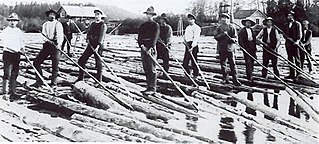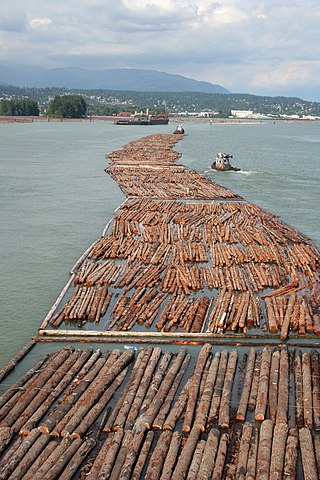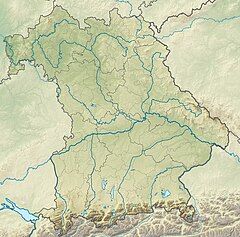
The Iller is a river of Bavaria and Baden-Württemberg in Germany. It is a right tributary of the Danube, 146 kilometres (91 mi) long.

The Zwickauer Mulde is a river in Saxony, Germany. It is the left tributary of the Mulde and 166 km (103 mi) in length.

The Wisconsin River is a tributary of the Mississippi River in the U.S. state of Wisconsin. At approximately 430 miles long, it is the state's longest river. The river's name was first recorded in 1673 by Jacques Marquette as "Meskousing" from his Indian guides - most likely Miami for "river running through a red place."

The Kennebec River is a 170-mile-long (270 km) river within the U.S. state of Maine. It rises in Moosehead Lake in west-central Maine. The East and West Outlets join at Indian Pond and the river flows southward. Harris Station Dam, the largest hydroelectric dam in the state, was constructed near that confluence. The river is joined at The Forks by its tributary the Dead River, also called the West Branch.

The Saalach is a 105-kilometre-long (65 mi) river in Austria and Germany, and a left tributary of the Salzach.

Reit im Winkl is a small village located on the German/Austrian border in the southeastern part of Bavaria, Germany. Part of the Traunstein district, it was previously an immigration and customs control point. It is situated south of Chiemsee and southwest of Ruhpolding – home of the Biathlon World Cup – in the Bavarian Alps and facing towards Tyrol. The village lies next to the Austrian states Tyrol and Salzburg. Kössen in Tyrol is the next village on the river Lofer, before it joins the confluence of the river Tiroler Achen. Reit im Winkl has a population of approximately 2,600.

The Murg is an 80.2-kilometre-long river and tributary of the Rhine in Baden-Württemberg, Germany. It flows through the Northern Black Forest into the Upper Rhine Plain, crossing the counties of Freudenstadt and Rastatt.

Log driving is a means of moving logs from a forest to sawmills and pulp mills downstream using the current of a river. It was the main transportation method of the early logging industry in Europe and North America.

Bicaz is a town in Neamț County, Western Moldavia, Romania situated in the eastern Carpathian Mountains near the confluence of the Bicaz and Bistrița Rivers and near Lake Bicaz, an artificial lake formed by the Bicaz Dam on the Bistrița. Bicaz used to be a border town until 1918. Six villages are administered by the town: Capșa, Dodeni, Izvoru Alb, Izvoru Muntelui, Potoci, and Secu.

Vișeu de Sus is a town in Maramureș County, Maramureș, Romania, located at the confluence of the rivers Vișeu and Vaser. It administers one village, Vișeu de Mijloc (Középvisó). The town has an area of 443 km2 (171 sq mi) and a population of 15,349 as of 2021. It is best known for the Mocăniță.

The Chippewa River in Wisconsin flows approximately 183 miles (294 km) through west-central and northwestern Wisconsin. It was once navigable for approximately 50 miles (80 km) of its length, from the Mississippi River, by Durand, northeast to Eau Claire. Its catchment defines a portion of the northern boundary of the Driftless Area. The river is easily accessible for bikers and pleasure seekers via the Chippewa River State Trail, which follows the river from Eau Claire to Durand.

The Hog's Back Falls, officially known as the Prince of Wales Falls, but rarely referred to by this name, are a series of artificial waterfalls on the Rideau River in Ottawa, Ontario, Canada. The falls are located just north of Mooney's Bay and the point where the Rideau Canal splits from the Rideau River.

Timber rafting is a method of transporting felled tree trunks by tying them together to make rafts, which are then drifted or pulled downriver, or across a lake or other body of water. It is arguably, after log driving, the second cheapest means of transporting felled timber. Both methods may be referred to as timber floating. The tradition of timber rafting cultivated in Austria, the Czech Republic, Germany, Latvia, Poland and Spain was inscribed on UNESCO Representative List of the Intangible Cultural Heritage of Humanity in 2022

The Dead River, sometimes called the West Branch, is a 42.6-mile-long (68.6 km) river in central Maine in the United States. Its source is Flagstaff Lake, where its two main tributaries, South Branch Dead River and North Branch Dead River, join. It flows generally east to join the Kennebec River at The Forks, Maine.

The Queich is a tributary of the Rhine, which rises in the southern part of the Palatinate Forest, and flows through the Upper Rhine valley to its confluence with the Rhine in Germersheim. It is 52 kilometres (32 mi) long and is one of the four major drainage systems of the Palatinate Forest along with the Speyerbach, Lauter and Schwarzbach. The Queich flows through the towns Hauenstein, Annweiler am Trifels, Siebeldingen, Landau, Offenbach an der Queich and Germersheim.

Örtze is a river of Lower Saxony, Germany. The Örtze rises north of Munster in the Große Heide and, after 62 kilometres (39 mi), joins the Aller southeast of Winsen.

The Ise is a 43 km (27 mi) long, almost natural river of East Lower Saxony and Saxony-Anhalt, Germany. It crosses the district of Gifhorn from north to south and discharges into the Aller at Gifhorn itself.

The Obere Schleuse in Hinterhermsdorf is a barrage system on the German-Czech border river of Kirnitzsch and impounds the water over a length of 700 metres. It was originally a facility for timber rafting. There are boat rides on the reservoir today during the summer months. At the boat landing point the water depth is 1 metre; by the dam it is 4 metres. The water temperature rarely climbs above 8 °C in summer. In the winter months, during when there are no boat trips, the water is not impounded and the Kirnitzsch flows in its original river bed.

The Ottawa River timber trade, also known as the Ottawa Valley timber trade or Ottawa River lumber trade, was the nineteenth century production of wood products by Canada on areas of the Ottawa River and the regions of the Ottawa Valley and western Quebec, destined for British and American markets. It was the major industry of the historical colonies of Upper Canada and Lower Canada and it created an entrepreneur known as a lumber baron. The trade in squared timber and later sawed lumber led to population growth and prosperity to communities in the Ottawa Valley, especially the city of Bytown. The product was chiefly red and white pine.The Ottawa River being conveniently located with access via the St. Lawrence River, was a valuable region due to its great pine forests surpassing any others nearby. The industry lasted until around 1900 as both markets and supplies decreased, it was then reoriented to the production of wood pulp which continued until the late 1990s and early 2000s.

The Herrenwieser Schwallung is a splash dam, built in 1844–47 of bunter sandstone, near Herrenwies in the Black Forest, which impounds the waters of the Schwarzenbach stream into a pond. In the days of timber rafting it was periodically opened and washed the fallen logs or timber rafts downstream into the valley. Today the dam acts as a bridge over the Schwarzenbach.





















